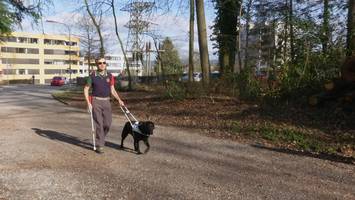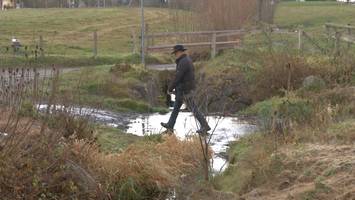Osteoarthritis of the big toe/hallux rigidus/hallux valgus
With osteoarthritis in the joint of the big toe, it is important to keep the joint as mobile as possible to enable the continued rollover of the foot over the big toe and so the affected individual does not develop a limp.
The kybun shoe and the kybun mat help keep the big toe mobile and improve mobility. This maintains a natural gait pattern and protects the higher joints (such as the knees, hips and back).
Definition
Hallux valgus (bunion deformity) is the medical term for the pathological lateral deviation of the big toe, which deviates towards the outside of the foot in the metatarso-phalangeal joint.
It is usually caused by a deviation of the metatarsal bone towards the inside edge of the foot. Wear of the metatarso-phalangeal joint or hallux rigidus (Osteoarthritis of the big toe) may be present at the same time.
Causes
Along with a hereditary predisposition, there are two causes for hallux valgus:
- Splayfoot: Sagging of the anterior transverse arch with splayfoot causes the ball of the foot to widen, changes the angles and therefore also leads to a skewed position, primarily in the first toe.
- Improper shoes: Intercultural comparisons prove that the main cause of hallux valgus is wearing improper shoes over many years. In the natural, healthy, normal foot, the toes are spread slightly apart – yet this is common in only few cultures today.
Among populations wearing western-style shoes on the other hand, the toes are usually close together. Therefore the natural radiant position of the toes has changed into a toe-lined position only. Studies show that merely wearing stockings, which after all push the toes together slightly, regularly over many years is enough to cause this. Wearing stockings that are too tight or short speeds up the process.
The most commonly worn shoes have an inner sole shape that does not correspond to the outline of the natural sole of the foot. This pushes the toes out of their natural position and leads to lasting deformation over time. The first indication in the advanced stage is a skewed position of the big toe (hallux valgus). This skewed position progresses, gradually also affecting the other toes and, in the big toe, can lead to a longitudinal axis that faces out nearly at a right angle and crosses the longitudinal axis of the neighbouring toes.
Pronounced hallux valgus is primarily seen in women. This is due on the one hand to the weaker connective tissue women have, but mainly to the shape of women’s shoes, which increase the risk of this improper development more than men’s shoes on male feet. Three factors regarding footwear are important:
- Heel height
A higher heel (more than three to four centimetres) increases pressure on the forefoot area. This encourages the development of splayfoot and pushes the toes into the toe cap.
- Toe cap too tight
Toe caps are often too tight and do not give the toes the room they need, especially sideways but also upwards. This forces them into an incorrect position, which leads to a permanent malposition in the joints of the foot over time. Many women have triangular forefeet when viewed from above, which fit exactly into the tapered toe caps of the shoes.
- Shoes too short
If the shoes are too short, the toes are also forced out of their natural position. This not only leads to hallux valgus but also to hammer toe and claw toe.
Long-term consequences
It is a fact that joints will increasingly stiffen if they are not moved. The impairment of joint mobility can proceed very quickly after the onset of osteoarthritis. Because of osteoarthritis in the toes, a natural rollover across the big toe is no longer possible for the affected individual, leading to avoidance movements. A limping mechanism develops subconsciously and this, in turn, puts excessive strain on other, higher joints such as the knees.
In order to prevent this, we encourage mobilisation of the feet – but only in small increments to avoid inflammation (the dosage must be determined individually).
Conventional therapy
- Physiotherapy: Active and passive movement therapy among other things
- Avoiding shoes that damage the feet
- Walking barefoot a lot
- Orthopaedic insoles
- Night splint to correct the malposition in the metatarso-phalangeal joint
The kybun principle of operation – being proactive
- The soft, elastic sole absorbs the impact of hard surfaces, gently loading the joint.
- The foot, with its very mobile natural construction, can move naturally, three-dimensionally on the soft, elastic sole. This gently mobilises the joints and promotes coordinative training of the foot musculature.
- During walking and rollover/pushing off with the big toe, the metatarso-phalangeal joint is mobilised and limited mobility is improved. This alleviates pain and reduces limping.
Initial reactions
Specific initial reactions with osteoarthritis in the big toe/hallux valgus/hallux rigidus:
If the mobility of the basal joint of the big toe is significantly limited, the rollover movement of the foot in the kybun shoe may cause pain in the joint in the beginning. This is normal; as long as this pain is tolerable, you don’t need to change your kybun training in any way (if it is not, you can find ways of adapting under ‘Application tips’). This allows you to mobilise the stiff toe joint (much like physiotherapy, which can also cause pain). The pain should decrease as soon as joint mobility improves. You can find more information under ‘Application tips’.
Generally speaking, so-called initial reactions in the kybun shoe can arise even if you have never had ‘hallux valgus symptoms’. Nevertheless, your big toe will have had movement impairment or other weaknesses that did not become apparent in ‘normal’ shoes.
Many people are unaccustomed to pushing off with the big toe, which can therefore be unpleasant or painful at first. People wearing ‘normal’ shoes with stiff soles usually roll over the outside of the foot and the little toe, but this movement is not ergonomic and can lead to overtaxation of the foot and possibly also of the knee, hip, etc. in the long run.
It may well be that pain resulting from overloading will not occur until night-time; it does not necessarily manifest while you are walking in the kybun shoe. This naturally makes it more difficult to determine the correct dosage in the kybun shoe.
Click here for the general initial reactions experienced by kybun mat and kybun shoe beginners: Initial reactions
kybun exercises
For information about the special kybun shoe exercises or the basic kybun mat exercises , please click here: kybun exercises
The following adaptations to the standard implementation of interval walking are important in case of bunions and hallux rigidus :
Bunions
- - take shorter steps during slow and fast exercises
- reduce power exerted in rollover movement
- mobilised basal joint of the big toe in such a way that there is no irritation - - focus more on fast exercise
- conduct slow exercises over a shorter period
Hallux rigidus
- see bunions
- With hallux rigidus, the mobilisation of the joint must be performed even more carefully.
- before interval walking, insert normal, thin orthopedic insoles into the kybun shoe
Application tips
For some osteoarthritis patients, the kybun shoe mobilises too greatly at first because the affected joint is already very stiff (severe movement impairment such as hallux rigidus). This can lead to inflammation if dosage is too high and should be avoided.
However, initial reactions in the kybun shoe can always arise at the body’s weak point and they are a sign that the kybun shoe is working at the right spot. As with many medications and therapies, dosage is critical.
If the kybun shoe is too soft at first and you have severe pain during foot rollover, we recommend that you temporarily use an insole in the kybun shoe that ‘stiffens’ the front part of your foot. You can find these thin soles in shoe stores. Such an insole will reduce the softness of the kybun shoe sole somewhat, and the affected joint will be mobilised a little less.
Ensure that the heel comes down first so that the heel area can absorb the impact of each step.
Do not make your steps too long. This takes some pressure off the big toe and ensures that it is not mobilised as much (or bent).
Some people feel too unstable in the kybun shoe. In this case, we advise you to try various kybun shoe models; some models have a higher cut and provide more stability. We also recommend a kybun shoe model with a lower rebound effect to these customers. It is a little wider in the mid-foot area, making you feel safer while walking (ask for advice in a specialised kybun shop).
If you still feel too unsafe walking in the kybun shoe, we advise using the kybun mat. The kybun mat is available in three different thicknesses. This allows you to choose the thickness that is most comfortable for you (the thicker, the less stable, and the more intensive the training).
You can also hold on to a fixed object if you need additional support when using the kybun mat.
For effective consultation, it is imperative that you remain in contact with the kybun partner of your choice (especially if you have experienced an adverse initial reaction) so that the specialist can advise you regarding these reactions.
Opinions/customer testimonials
I broke three vertebrae in my back in an accident eight years ago. I have suffered from neurological complaints ever since. In normal shoes I have pain in my upper thoracic spine and feel tense in my neck. I also have a minor hallux condition. Thanks to the kybun shoe, I can walk without any pain. It is simply phenomenal. Walking is very enjoyable and I hardly notice the hallux anymore.








![[Translate to English:] Erika Wissmann](/fileadmin/_processed_/5/d/csm_Erika-Wissmann_9d413fc98f.jpg)




